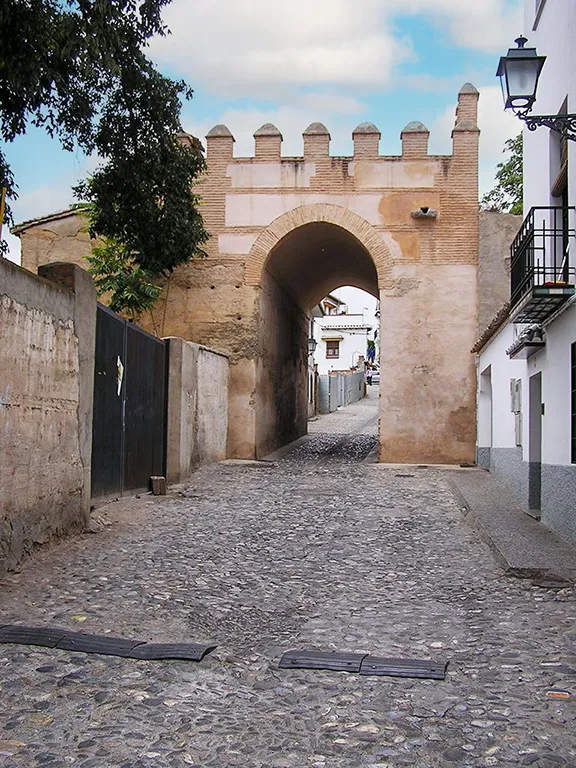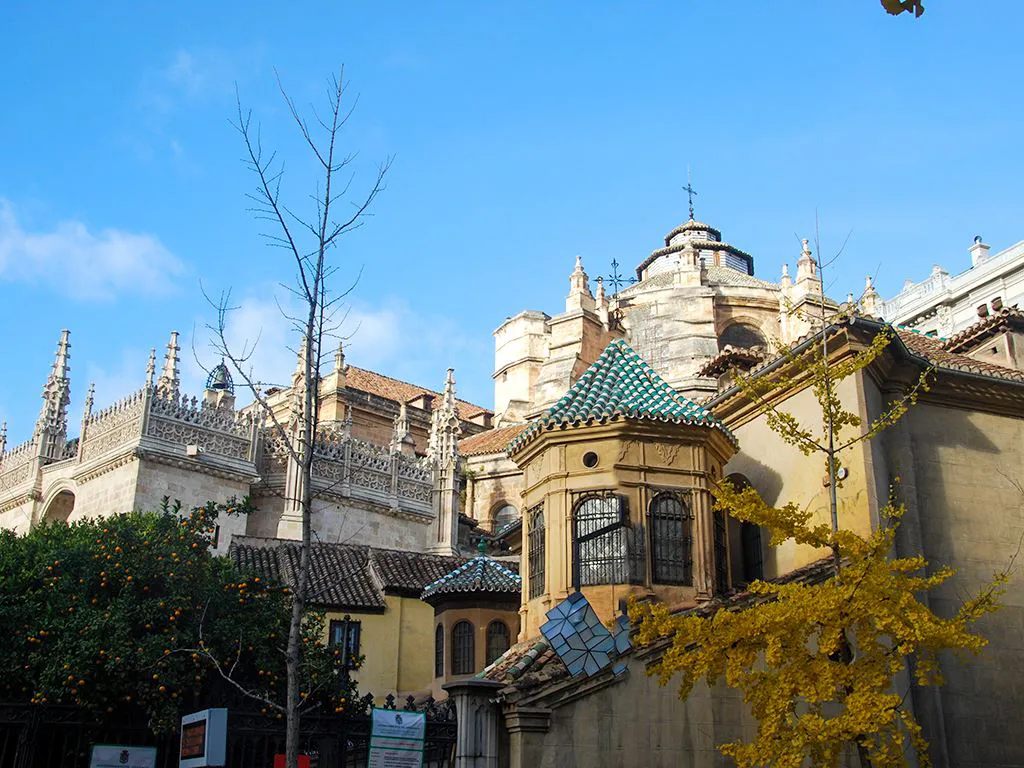Mention the city of Granada and most people immediately think ‘Alhambra, Muslims, al-Andalus, the Emirate of Granada’ and possibly ‘Nasrids’. It is as though the city had no history before the Muslim occupation after 711 AD.
By Nick Nutter | Updated 21 Sep 2022 | Granada | Cities |
Login to add to YOUR Favourites or Read Later


Granada an opulent city
The history of the city of Granada is the story of a city that grew to be one of the most opulent and admired cities in the known world to rapidly decline into the poorest city in Spain.


Albaicin from the Alhambra
Unearthing the history of Granada has been a fascinating task. It is easy to discount fables, for instance one such foundation myth mentions Noah, another mentions the Greek god Hercules, yet another mentions the Turdulos, an Iberian tribe related to the almost mythical Tartessian civilisation.


Elvira Gate
It is the latter fable that contains a kernel of accuracy. Following the Battle of Llipa in 206 BC, when the Republican Roman army defeated the Carthaginian forces, the Romans set about consolidating their hold on southern Spain, an area they called Hispania Ulterior. The Romans were particularly interested in metals, copper, gold, silver and lead. When they arrived in the vicinity of modern day Granada, they found a settlement occupied by Iberians called Ihverir.


Granada Cathedral
Ihverir was, according to Roman historians, founded by the Tartessians. The Iberian tribes generally welcomed the Romans, as their Tartessian forefathers had welcomed the Phoenicians and Greeks, and soon established cordial trading relationships. Ihverir was renamed IIiberis. It is unclear as to whether the discover of gold in the nearby Cerro del Sol predated or post-dated the arrival of the Romans. Either way, the mines of the Cerro del Oro (Hill of gold), become one of the most productive gold mines in Spain.


San Jose
The remains of the Ibero-Roman settlement have been found in the neighbourhoods of the Albaicin and the side of the hill on which the Alhambra now sits.
During the Visigothic period, from the 5th century AD, an area known as Granata, adjacent to the Ibero-Roman site in what became the Alcazaba, was developed as a Jewish enclave. There are some indications that Granata was the capital city of the province during the Visigothic period.
The Muslims arrived and renamed IIiberis, Elvira. Elvira was destroyed in 1010 AD, during the Fitna of al-Andalus that led to the breakdown of the caliphate of Córdoba. Zawi ben Ziri established an independent kingdom, the Taifa of Granada. Whilst Arab sources such as al-Idrisi consider him to be the founder of the city of Granada, as we have seen, a settlement, albeit destroyed, already existed, Granata. It was in the Granata area that Zawi ben Ziri established his residence. Within a short time Granata was transformed into one of the most important cities of al-Andalus with a mixed population of Christians, Muslims, and Jews.
The Zirids built their citadel and palace on the hill now occupied by the Albaicín neighborhood. It was connected to two smaller fortresses on the Sabika hill (site of the future Alhambra) and Mauror hill to the south. The city around it grew during the 11th century to include the Albaicín, the Sabika, the Mauror, and a part of the surrounding plains. The city was fortified with walls. The northern part of these walls, near the Albaicin citadel, have survived to the present day, along with two of its gates: Puerta Monaita in Spanish and Arco de las Pesas or Puerta Nueva. In the western wall, the still standing Puerta de Elvira was the main access to the city. The now-ruined Puerta de los Tableros was built to guard the city entrance along the Darro River. The nearby hammam or bathhouse, probably dates from this time, as does the former minaret of a mosque in the Albaicín, now part of the Church of San José.
The most powerful person in Granada at this time was Samuel ibn Naghrillah, an Andalusian Jew born in Mérida in 993 who fled to Granada during the Fitna and who became a tax collector and leader of the army. Under his influence, Granada became the centre of Jewish Sephardi culture and scholarship.
In 1066, jealous of the Jewish influence and prosperity, a Muslim mob stormed the royal palace and crucified the Jewish vizier, Joseph ibn Naghrela (Samuel’s son), and massacred most of the Jews in the city. In the late 11th century, the Zirids were supplanted by the Almoravid family, who ruled Granada from 1090 and they in turn were replaced by the Almohads from 1166, neither of whom left much of a lasting impression on the city.
In 1226, Almohad rule in al-Andalus collapsed and the area disintegrated into a hodge podge of local rulers and factions. This disunity was exploited by Christian forces who started a determined reconquest until by the late 13th century, only the Emirate of Granada, and a few Muslim enclaves such as Niebla and Jerez on the borders of the Emirate still existed under Muslim rule. So was born the Nasrid dynasty that was to last until 1492. After 1246 Granada became a tributary state to the Kingdom of Castile, although this was often interrupted by wars between the two states.It is during this period that the Nasrid Palaces within the Alhambra and much of the Alhambra itself that we see today, was built.
Over the next 250 years, Granada became one of the most opulent and admired cities in the known world.
On 2 January 1492, the last Muslim ruler in Iberia, Emir Muhammad XII, known as ‘Boabdil’ surrendered control of the Emirate of Granada to the Catholic Monarchs, Ferdinand II of Aragon and Isabella I of Castile. In accordance with reconquest tradition, and as written into in the Treaty of Granada, Muslim inhabitants, known as mudéjares, were allowed to continue unmolested in the practice of their faith and customs. Jewish inhabitants were to convert to Christianity or leave the city within three years. This provision was quickly superseded by the Alhambra Decree, issued only a few months later on March 31 1492, which instead forced all Jews in Spain to convert or be expelled within four months.
Over the following years, other rights, guaranteed to Muslims by the Treaty of Granada were eroded, causing uncertainty, tension and fear. Many of those that could afford to leave emigrated to North Africa.
In 1499, Cardinal Francisco Jiménez de Cisneros, frustrated by the slow conversion rate, started a programme of forced baptisms, creating a class called Conversos. This outraged the Muslims and led to the Rebellion of the Alpujurras. Following the rebellion, in 1501, the Treaty of Granada was rescinded and Granada’s Muslims had to convert or emigrate. Many of the Mudejares converted and became known as Moriscos, many others emigrated.
Over the 16th century Granada became more Catholic and both Moriscos and Mudejares were increasingly subject to persecution, execution, or exile. Many of the mosques in the city were converted into churches at this time. The cathedral was started in 1523 on the site of just such a mosque (although it was not completed until 1704).
In 1568, the Moriscos rebelled against increasing persecution in the Second Morisco Rebellion. This was swiftly suppressed and King Philip II ordered the expulsion of the vast majority of the morisco population from the Kingdom of Granada, with the exception of those artisans and professionals judged essential to the economy.
The Moriscos, a substantial part of the population, had finally been expelled from all Castille and Aragon by 1614. Despite efforts to repopulate the city from other areas of Spain, the 17th century saw the city stagnate.
During the Peninsular War, between 1810 and 1812, Granada was occupied by French troops, billeted in the Alhambra. As they left they tried to dynamite the whole Alhambra complex, successfully demolishing eight towers before the remaining fuses were extinguished by Spanish troops.
The 19th century was a turbulent time throughout Spain with riots and friction between landlords and peasants. Not to mention the three Carlist Wars, fought over claims to the throne, from 1833 – 1840, 1846 – 1849 and 1872 – 1876. Events inevitably led to the Spanish Civil War.
In 1936, at the outbreak of the Spanish Civil War, the city of Granada joined the Nationalist cause. Even within the city this was contentious with Republicans in the Albaicin area who were violently repressed. After the war, until the advent of tourism towards the end of the 20th century, Granada was one of the poorest areas in Spain.